Jie Ma
SDGOCC: Semantic and Depth-Guided Bird's-Eye View Transformation for 3D Multimodal Occupancy Prediction
Jul 22, 2025Abstract:Multimodal 3D occupancy prediction has garnered significant attention for its potential in autonomous driving. However, most existing approaches are single-modality: camera-based methods lack depth information, while LiDAR-based methods struggle with occlusions. Current lightweight methods primarily rely on the Lift-Splat-Shoot (LSS) pipeline, which suffers from inaccurate depth estimation and fails to fully exploit the geometric and semantic information of 3D LiDAR points. Therefore, we propose a novel multimodal occupancy prediction network called SDG-OCC, which incorporates a joint semantic and depth-guided view transformation coupled with a fusion-to-occupancy-driven active distillation. The enhanced view transformation constructs accurate depth distributions by integrating pixel semantics and co-point depth through diffusion and bilinear discretization. The fusion-to-occupancy-driven active distillation extracts rich semantic information from multimodal data and selectively transfers knowledge to image features based on LiDAR-identified regions. Finally, for optimal performance, we introduce SDG-Fusion, which uses fusion alone, and SDG-KL, which integrates both fusion and distillation for faster inference. Our method achieves state-of-the-art (SOTA) performance with real-time processing on the Occ3D-nuScenes dataset and shows comparable performance on the more challenging SurroundOcc-nuScenes dataset, demonstrating its effectiveness and robustness. The code will be released at https://github.com/DzpLab/SDGOCC.
ChartSketcher: Reasoning with Multimodal Feedback and Reflection for Chart Understanding
May 25, 2025Abstract:Charts are high-density visualization carriers for complex data, serving as a crucial medium for information extraction and analysis. Automated chart understanding poses significant challenges to existing multimodal large language models (MLLMs) due to the need for precise and complex visual reasoning. Current step-by-step reasoning models primarily focus on text-based logical reasoning for chart understanding. However, they struggle to refine or correct their reasoning when errors stem from flawed visual understanding, as they lack the ability to leverage multimodal interaction for deeper comprehension. Inspired by human cognitive behavior, we propose ChartSketcher, a multimodal feedback-driven step-by-step reasoning method designed to address these limitations. ChartSketcher is a chart understanding model that employs Sketch-CoT, enabling MLLMs to annotate intermediate reasoning steps directly onto charts using a programmatic sketching library, iteratively feeding these visual annotations back into the reasoning process. This mechanism enables the model to visually ground its reasoning and refine its understanding over multiple steps. We employ a two-stage training strategy: a cold start phase to learn sketch-based reasoning patterns, followed by off-policy reinforcement learning to enhance reflection and generalization. Experiments demonstrate that ChartSketcher achieves promising performance on chart understanding benchmarks and general vision tasks, providing an interactive and interpretable approach to chart comprehension.
Deliberation on Priors: Trustworthy Reasoning of Large Language Models on Knowledge Graphs
May 21, 2025Abstract:Knowledge graph-based retrieval-augmented generation seeks to mitigate hallucinations in Large Language Models (LLMs) caused by insufficient or outdated knowledge. However, existing methods often fail to fully exploit the prior knowledge embedded in knowledge graphs (KGs), particularly their structural information and explicit or implicit constraints. The former can enhance the faithfulness of LLMs' reasoning, while the latter can improve the reliability of response generation. Motivated by these, we propose a trustworthy reasoning framework, termed Deliberation over Priors (DP), which sufficiently utilizes the priors contained in KGs. Specifically, DP adopts a progressive knowledge distillation strategy that integrates structural priors into LLMs through a combination of supervised fine-tuning and Kahneman-Tversky optimization, thereby improving the faithfulness of relation path generation. Furthermore, our framework employs a reasoning-introspection strategy, which guides LLMs to perform refined reasoning verification based on extracted constraint priors, ensuring the reliability of response generation. Extensive experiments on three benchmark datasets demonstrate that DP achieves new state-of-the-art performance, especially a Hit@1 improvement of 13% on the ComplexWebQuestions dataset, and generates highly trustworthy responses. We also conduct various analyses to verify its flexibility and practicality. The code is available at https://github.com/reml-group/Deliberation-on-Priors.
NTIRE 2025 Challenge on UGC Video Enhancement: Methods and Results
May 05, 2025Abstract:This paper presents an overview of the NTIRE 2025 Challenge on UGC Video Enhancement. The challenge constructed a set of 150 user-generated content videos without reference ground truth, which suffer from real-world degradations such as noise, blur, faded colors, compression artifacts, etc. The goal of the participants was to develop an algorithm capable of improving the visual quality of such videos. Given the widespread use of UGC on short-form video platforms, this task holds substantial practical importance. The evaluation was based on subjective quality assessment in crowdsourcing, obtaining votes from over 8000 assessors. The challenge attracted more than 25 teams submitting solutions, 7 of which passed the final phase with source code verification. The outcomes may provide insights into the state-of-the-art in UGC video enhancement and highlight emerging trends and effective strategies in this evolving research area. All data, including the processed videos and subjective comparison votes and scores, is made publicly available at https://github.com/msu-video-group/NTIRE25_UGC_Video_Enhancement.
FortisAVQA and MAVEN: a Benchmark Dataset and Debiasing Framework for Robust Multimodal Reasoning
Apr 02, 2025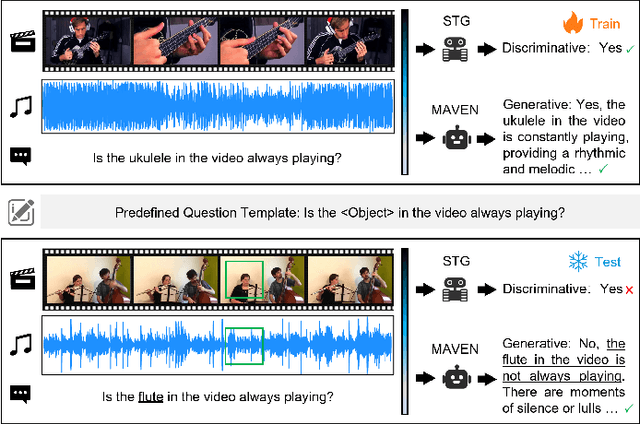

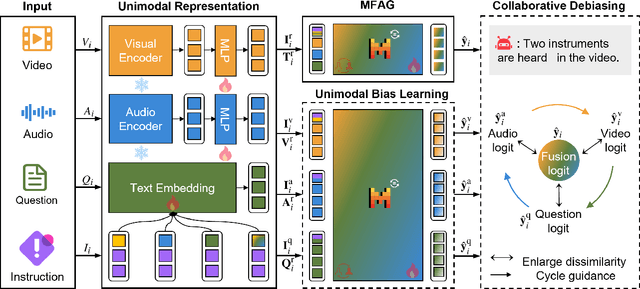
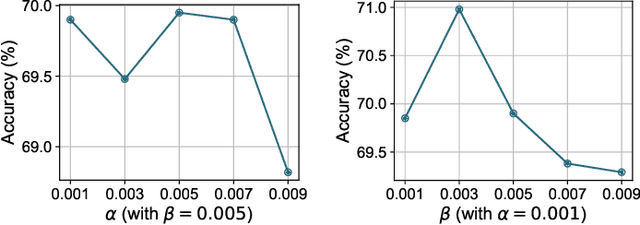
Abstract:Audio-Visual Question Answering (AVQA) is a challenging multimodal reasoning task requiring intelligent systems to answer natural language queries based on paired audio-video inputs accurately. However, existing AVQA approaches often suffer from overfitting to dataset biases, leading to poor robustness. Moreover, current datasets may not effectively diagnose these methods. To address these challenges, we first introduce a novel dataset, FortisAVQA, constructed in two stages: (1) rephrasing questions in the test split of the public MUSIC-AVQA dataset and (2) introducing distribution shifts across questions. The first stage expands the test space with greater diversity, while the second enables a refined robustness evaluation across rare, frequent, and overall question distributions. Second, we introduce a robust Multimodal Audio-Visual Epistemic Network (MAVEN) that leverages a multifaceted cycle collaborative debiasing strategy to mitigate bias learning. Experimental results demonstrate that our architecture achieves state-of-the-art performance on FortisAVQA, with a notable improvement of 7.81\%. Extensive ablation studies on both datasets validate the effectiveness of our debiasing components. Additionally, our evaluation reveals the limited robustness of existing multimodal QA methods. We also verify the plug-and-play capability of our strategy by integrating it with various baseline models across both datasets. Our dataset and code are available at https://github.com/reml-group/fortisavqa.
Multimodal Point Cloud Semantic Segmentation With Virtual Point Enhancement
Apr 02, 2025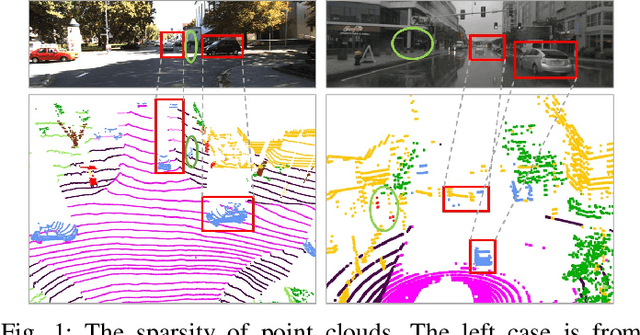
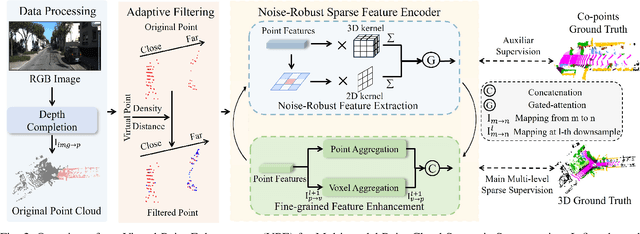


Abstract:LiDAR-based 3D point cloud recognition has been proven beneficial in various applications. However, the sparsity and varying density pose a significant challenge in capturing intricate details of objects, particularly for medium-range and small targets. Therefore, we propose a multi-modal point cloud semantic segmentation method based on Virtual Point Enhancement (VPE), which integrates virtual points generated from images to address these issues. These virtual points are dense but noisy, and directly incorporating them can increase computational burden and degrade performance. Therefore, we introduce a spatial difference-driven adaptive filtering module that selectively extracts valuable pseudo points from these virtual points based on density and distance, enhancing the density of medium-range targets. Subsequently, we propose a noise-robust sparse feature encoder that incorporates noise-robust feature extraction and fine-grained feature enhancement. Noise-robust feature extraction exploits the 2D image space to reduce the impact of noisy points, while fine-grained feature enhancement boosts sparse geometric features through inner-voxel neighborhood point aggregation and downsampled voxel aggregation. The results on the SemanticKITTI and nuScenes, two large-scale benchmark data sets, have validated effectiveness, significantly improving 2.89\% mIoU with the introduction of 7.7\% virtual points on nuScenes.
Single-Step Latent Consistency Model for Remote Sensing Image Super-Resolution
Mar 25, 2025


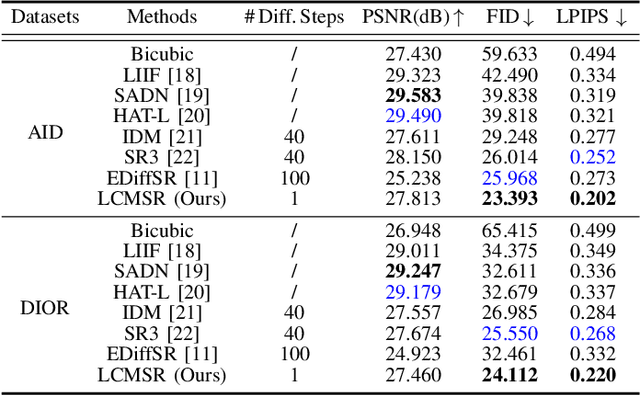
Abstract:Recent advancements in diffusion models (DMs) have greatly advanced remote sensing image super-resolution (RSISR). However, their iterative sampling processes often result in slow inference speeds, limiting their application in real-time tasks. To address this challenge, we propose the latent consistency model for super-resolution (LCMSR), a novel single-step diffusion approach designed to enhance both efficiency and visual quality in RSISR tasks. Our proposal is structured into two distinct stages. In the first stage, we pretrain a residual autoencoder to encode the differential information between high-resolution (HR) and low-resolution (LR) images, transitioning the diffusion process into a latent space to reduce computational costs. The second stage focuses on consistency diffusion learning, which aims to learn the distribution of residual encodings in the latent space, conditioned on LR images. The consistency constraint enforces that predictions at any two timesteps along the reverse diffusion trajectory remain consistent, enabling direct mapping from noise to data. As a result, the proposed LCMSR reduces the iterative steps of traditional diffusion models from 50-1000 or more to just a single step, significantly improving efficiency. Experimental results demonstrate that LCMSR effectively balances efficiency and performance, achieving inference times comparable to non-diffusion models while maintaining high-quality output.
Dual-Domain Homogeneous Fusion with Cross-Modal Mamba and Progressive Decoder for 3D Object Detection
Mar 12, 2025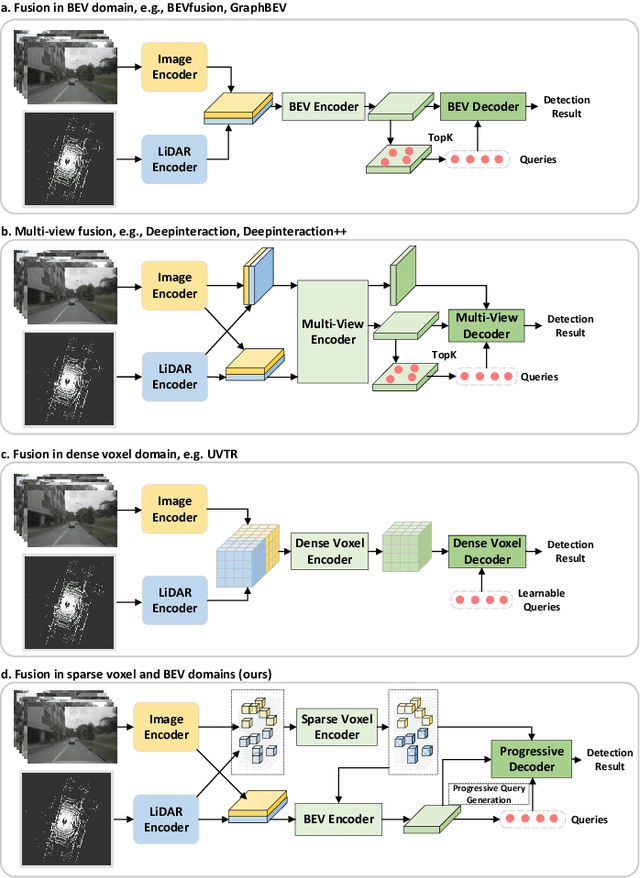
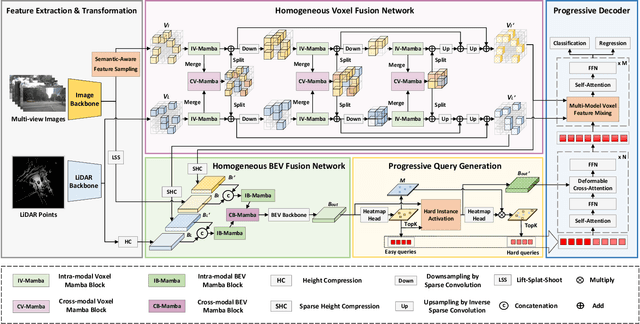
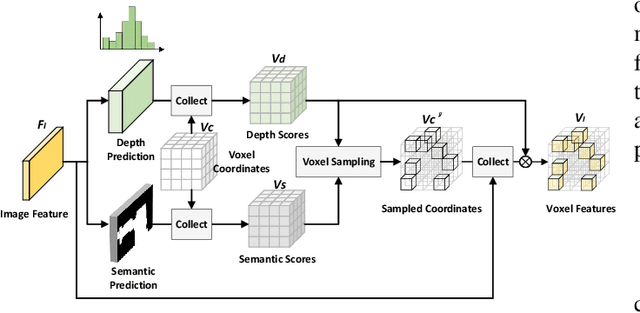
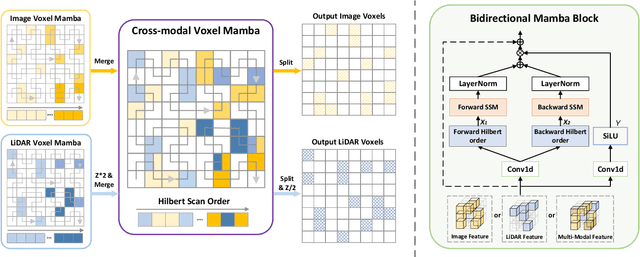
Abstract:Fusing LiDAR point cloud features and image features in a homogeneous BEV space has been widely adopted for 3D object detection in autonomous driving. However, such methods are limited by the excessive compression of multi-modal features. While some works explore feature fusion in dense voxel spaces, they suffer from high computational costs and inefficiencies in query generation. To address these limitations, we propose a Dual-Domain Homogeneous Fusion network (DDHFusion), which leverages the complementary advantages of both BEV and voxel domains while mitigating their respective drawbacks. Specifically, we first transform image features into BEV and sparse voxel spaces using LSS and our proposed semantic-aware feature sampling module which can significantly reduces computational overhead by filtering unimportant voxels. For feature encoding, we design two networks for BEV and voxel feature fusion, incorporating novel cross-modal voxel and BEV Mamba blocks to resolve feature misalignment and enable efficient yet comprehensive scene perception. The output voxel features are injected into the BEV space to compensate for the loss of 3D details caused by height compression. For feature decoding, a progressive query generation module is implemented in the BEV domain to alleviate false negatives during query selection caused by feature compression and small object sizes. Finally, a progressive decoder can sequentially aggregate not only context-rich BEV features but also geometry-aware voxel features, ensuring more precise confidence prediction and bounding box regression. On the NuScenes dataset, DDHfusion achieves state-of-the-art performance, and further experiments demonstrate its superiority over other homogeneous fusion methods.
Positioning-Aided Channel Estimation for Multi-LEO Satellite Downlink Communications
Feb 09, 2025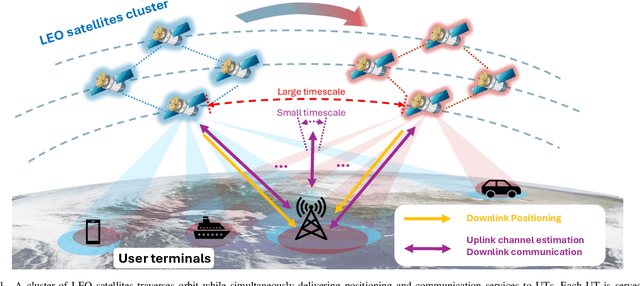
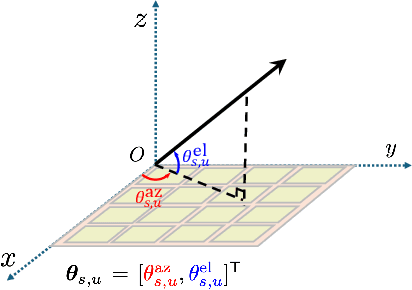

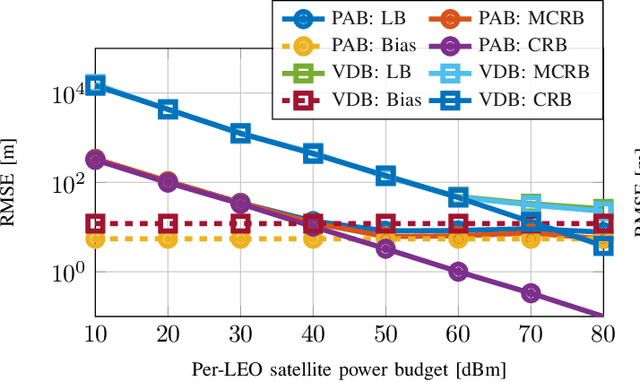
Abstract:We investigate a multi-low Earth orbit (LEO) satellite system that simultaneously provides positioning and communication services to terrestrial user terminals. To address the challenges of channel estimation in LEO satellite systems, we propose a novel two-timescale positioning-aided channel estimation framework, exploiting the distinct variation rates of position-related parameters and channel gains inherent in LEO satellite channels. Using the misspecified Cramer-Rao bound (MCRB) theory, we systematically analyze positioning performance under practical imperfections, such as inter-satellite clock bias and carrier frequency offset. Furthermore, we theoretically demonstrate how position information derived from downlink positioning can enhance uplink channel estimation accuracy, even in the presence of positioning errors, through an MCRB-based analysis. To overcome the constraints of limited link budgets and communication rates associated with single-satellite-based communication, we develop a distributed beamforming strategy for downlink communication. This strategy allows LEO satellites to independently optimize their beamformers using local channel state information, eliminating the need for centralized processing while preserving the advantages of multi-satellite cooperative communication. Theoretical analyses and numerical results confirm the effectiveness of the proposed framework in achieving high-precision downlink positioning under practical imperfections, facilitating uplink channel estimation, and enabling efficient downlink communication.
Integrated Positioning and Communication via LEO Satellites: Opportunities and Challenges
Nov 21, 2024



Abstract:Low Earth orbit (LEO) satellites, as a prominent technology in the 6G non-terrestrial network, offer both positioning and communication capabilities. While these two applications have each been extensively studied and have achieved substantial progress in recent years, the potential synergistic benefits of integrating them remain an underexplored yet promising avenue. This article comprehensively analyzes the integrated positioning and communication (IPAC) systems on LEO satellites. By leveraging the distinct characteristics of LEO satellites, we examine how communication systems can enhance positioning accuracy and, conversely, how positioning information can be exploited to improve communication efficiency. In particular, we present two case studies to illustrate the potential of such integration. Finally, several key open research challenges in the LEO-based IPAC systems are discussed.
 Add to Chrome
Add to Chrome Add to Firefox
Add to Firefox Add to Edge
Add to Edge